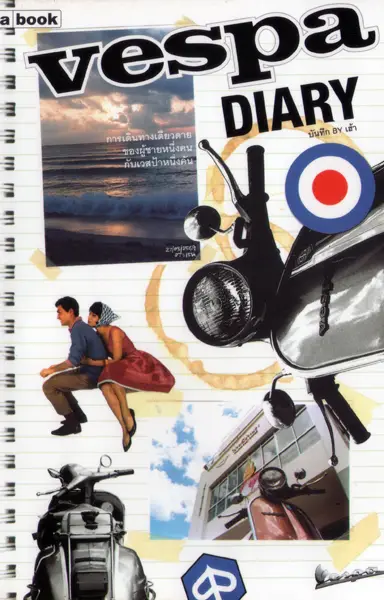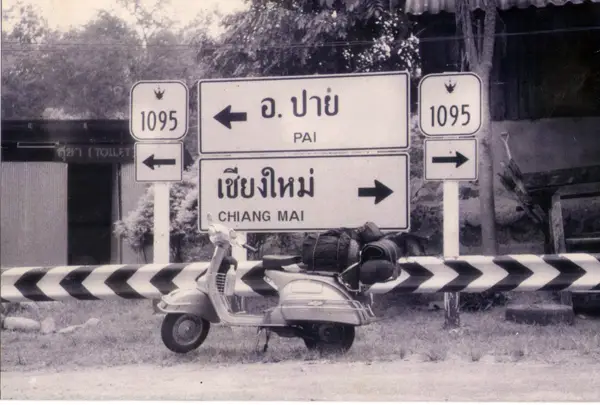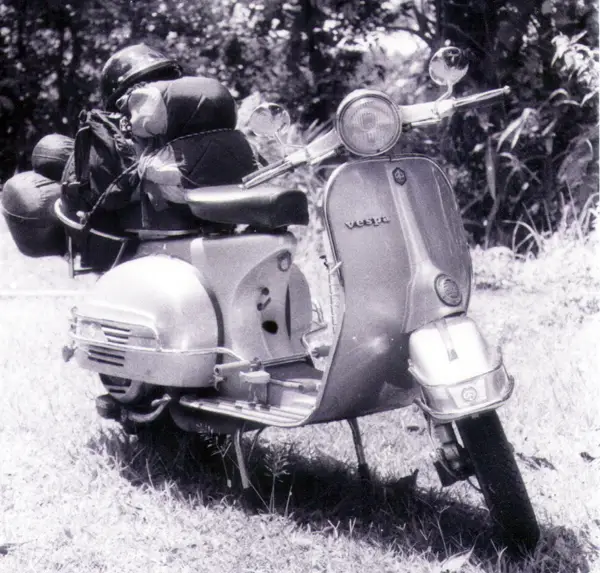The same way bicycles are part of the daily life of people in China, motorbikes are imbedded in the Thai way of life. On how many occasions have we been saved from being late to work by employing the services of a motorbike taxi driver? How many times have we been angered by the recklessness of some of these drivers? How many times have we seen accidents that involved motorbikes? The answers to all these questions is, for sure, “Many.” Like it or not, if you live in Thailand, motorbikes are everywhere and we’d better make the most out of them.
Still, there are many people, both Thai and foreigners, for whom motorbikes and scooters are more than just a means of transportation. They are a passion, a way of living their life and, at the same time, a way of making a stand to what they believe in. Why else would anyone choose to ride an old and battered scooter rather than sell it and buy a fairly inexpensive modern 100cc motorbike?
There is a special group of people living all around Thailand who care more for their motorbikes and scooters than anything else in their lives. This is especially true for riders who have refused their peer’s pressure to buy new cars or new motorbikes and have chosen to stick with their lifelong travel companions: their good ol’ Vespas.
The Italian-made vehicle has been popular with the Thais for quite a long time and many expatriates have also continued their love affair with the Vespa even after they have relocated to Thailand. When a scooter becomes to mean so much to its owner, it is of no surprise that the Vespa becomes the favourite means of transplantation. Even if we’re talking about hundreds of kilometers.
Take for example Sonkot “Hao” Bangykan, the author of Vespa Diary. In his small booklet published by A Book in 2006, he recorded, for the Thai readers, his journey from Bangkok to Ranong. The book has long since been out of print but, if you’re lucky, you might find it at a secondhand bookstall at the Chatuchak Weekend Market. Using a conversational style, the author, recollects his experiences during the 580-kilometer ride to the south of Thailand.
A similar but longer journey was done by Romanian travel journalist, Brad Florescu, who, between 2010 and 2011, covered a total distance of 7.700 kilometers at the “wheel” of a saleng, a motorcycle with a side car. It took him four months, but there is no doubt that the trip was worth every kilometer.
More recently, James Stadtler, a 49-year-old American from California, has toured the north of Thailand on a 1969 Vespa 150 Sprint. James, or Jim to his friends, has been living in Thailand on and off for ten years. He is now employed at Keerapat International School in Bangkok as an education consultant specializing in environmental science, outdoor education, and the social sciences.
He has owned a Vespa scooter for many years and his decision to ride the 750 kilometers from Chiang Mai to Bangkok was mainly influenced by his reading and understanding of Robert M. Pirsig’s philosophical novel Zen and the Art of Motorcycle Maintenance: An Inquiry into Values.
“I am a traveler and have climbed mountains, rafted rivers, hiked and biked many trails, but never made a long distance motorcycle ride,” he said. When an opportunity to do something different arose, James decided to go for it. “It seemed like a good challenge. Why not? I asked myself. I like to ride on my scooter. It makes me feel cool from the warm weather and free from any obligations. I can go anywhere.”
Just like Sonkot Bangykan and Brad Florescu’s trips, Jim’s Vespa journey might seem odd. People generally use scooters and motorbikes to move from A to B in the quickest way possible. But, for James Stadtler, this was quite the opposite. He had all the time in the world: “I had the time to travel leisurely and it just seemed right. I’ve owned Vespas since I was 18. I know how to fix flat tires as well as basic engine repair. I have ridden my scooter in many parts of California and Mexico. Going on rallies in California is not uncommon for Vespa enthusiasts and those who belong to Scooter clubs.”
Jim’s Thai journey began at Hua Lamphong train station in Bangkok where, after he showed his owner’s papers, the train attendants put his scooter aboard a train to Chiang Mai. He disembarked the next morning, got on his Vespa, and drove straight to Pai. “Here I spent several days traveling the country roads which motivated me to go further north. I went to Fang and spent the night in a bungalow near the river and woke up early to start for Chiang Rai. I had a mission to meet a famous Thai artist, Tawan Duchanee, who has built many artistic Thai houses and temples. I spent two days there checking out the artwork and then pushed on to Nan, Prae, Lampang, and Lampoon,” recalled James.
During his ‘Vespa trip,’ he met many Thai farmers working the rice fields of the northern region. He spent many nights in salas, Thai-style open pavilions, right next to the road and the rice fields. “I set up my mosquito net, rolled out my summer sleeping bag and turned on my headlamp for my nightly reading and slowly drifted off to sleep. I had no fear other than snakes,” Jim said with a smile on his face.
 After his trip to these provinces, he drove back to Pai and headed to Mae Hong Son. According to James, the country roads in this area are built for scooter riding so they were easy to travel. “The roads were well built, and signs made it easy to calculate my milage,” he remembered. After another stop in Tak. where he spent several days with the family of a friend, working in their fruit tree farm, he started on the long road back to Bangkok. “This was the dullest part of my journey. I drove along the main highway as there were no shortcuts or country roads that could lead me to the capital. It took about two days to complete my journey.”
After his trip to these provinces, he drove back to Pai and headed to Mae Hong Son. According to James, the country roads in this area are built for scooter riding so they were easy to travel. “The roads were well built, and signs made it easy to calculate my milage,” he remembered. After another stop in Tak. where he spent several days with the family of a friend, working in their fruit tree farm, he started on the long road back to Bangkok. “This was the dullest part of my journey. I drove along the main highway as there were no shortcuts or country roads that could lead me to the capital. It took about two days to complete my journey.”
Obviously, James Stadtler is not afraid of spending time alone and enjoys the freedom of choosing his own destinations. “If I was tired, I stopped. If I wanted to sleep, I slept where I wanted, mainly in bungalows and salas. I usually awoke before sunrise and then proceeded to get on the road while it was still nice and cool.”
But there’s no real journey without some real challenges, and Jim wasn’t spared. On the way back to Bangkok, just a few hours’ drive from his home, he broke a clutch cable: “Keeping my cool, I knew I could bump-start the scooter and shift the rest of the gears by doing the same procedure, bumping the gears. I do not recommend this, but when you are in survival mode, you have to do what you have to do. I knew I would be home soon enough and could get a mechanic to fix it.”
So, what was the point of this journey? For James Stadtler it was zen and a feeling of accomplishment. “No one I have ever known has ever ridden their Vespa in Thailand the way I had. The memories I have come back home with will forever be with me.”
If you’re interested in taking your scooter on a longer journey in Thailand, you can find more information about the “scooter movement” at the Thai Scooter forum or you can join the guys at Vespa Club Thailand. Either way, you’ll be in good company!
Originally published in
“Bangkok Trader” (Vol. 6, No.11, September 2012)





Wow! This is so cool. I didn’t know Jim did this. COngrats for this great travel Jim. And a very nice, well-written article again, Mihnea.
Hey, Regin. We’re so engrossed with our work at school that we fail to realized that our colleagues are actually very cool people.
(You’re writing is pretty good too! I’m inviting you to send me a guest post…)
Wow, Fantastic…. Super Jim ! I can follow his writing and imagine how exciting and challenging it was. I love the North as I spent 4 years there but I wonder how many days he spent for this trip ?
That’s awesome, i’m concidering doing something similar, maybe not on a Vespa though, perhaps an ER6